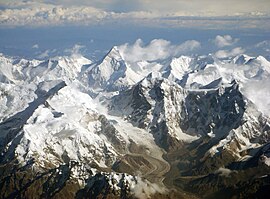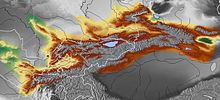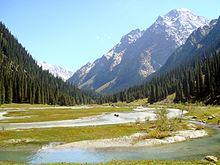Tian Shan
| Tian Shan | |
|---|---|
 The Tian Shan range on the border between China and Kyrgyzstan with Khan Tengri (7,010 m) visible at center | |
| Highest point | |
| Peak | Jengish Chokusu |
| Elevation | 7,439 m (24,406 ft) |
| Coordinates | 42°02′06″N 80°07′32″E / 42.03500°N 80.12556°E / 42.03500; 80.12556 |
| Geography | |
| Countries | List
|
| Range coordinates | 42°N 80°E / 42°N 80°E / 42; 80Coordinates: 42°N 80°E / 42°N 80°E / 42; 80 |
| Geology | |
| Age of rock | Mesozoic and Cenozoic |
UNESCO World Heritage Site | |
| Official name | Xinjiang Tianshan |
| Type | Natural |
| Criteria | vii, ix |
| Designated | 2013 (37th session) |
| Reference no. | 1414 |
| State Party | China |
| Region | Asia |
UNESCO World Heritage Site | |
| Official name | Western Tien-Shan |
| Type | Natural |
| Criteria | x |
| Designated | 2016 (40th session) |
| Reference no. | 1490 |
| State Party | Kazakhstan, Kyrgyzstan, and Uzbekistan |
| Region | Asia |
The Tian Shan,[a] also known as the Tengri Tagh, meaning the Mountains of Heaven or the Heavenly Mountain, is a large system of mountain ranges located in Central Asia. The highest peak in the Tian Shan is Jengish Chokusu, at 7,439 metres (24,406 ft) high. Its lowest point is the Turpan Depression, which sits at 154 m (505 ft) below sea level.[1]
The Chinese name for Tian Shan may have been derived from the Xiongnu word Qilian (simplified Chinese: 祁连; traditional Chinese: 祁連; pinyin: Qí lián) – according to Tang commentator Yan Shigu, Qilian is the Xiongnu word for sky or heaven.[2]Sima Qian in the Records of the Grand Historian mentioned Qilian in relation to the homeland of the Yuezhi, and the term is believed to refer to the Tian Shan rather than the Qilian Mountains 1,500 kilometres (930 mi) further east now known by this name.[3][4] The Tannu-Ola mountains in Tuva has the same meaning in its name ("heaven/celestial mountains" or "god/spirit mountains"). Tian Shan is sacred in Tengrism, and its second-highest peak is known as Khan Tengri which may be translated as "Lord of the Spirits".[5]
Contents
1 Geography
2 Ranges
3 Ice Age
4 Ecology
5 Religion
5.1 Chinese religion
5.2 Tengrism
6 World Heritage Site
7 See also
8 Notes
9 References
10 External links
Geography
Tian Shan is north and west of the Taklamakan Desert and directly north of the Tarim Basin in the border region of Kazakhstan, Kyrgyzstan, and Xinjiang in northwest China. In the south it links up with the Pamir Mountains and to north and east it meets the Altai Mountains of Mongolia.
In Western cartography such as National Geographic, the eastern end of the Tian Shan is usually understood to be east of Ürümqi, with the range to the east of that city known as the Bogda Shan as part of the Tian Shan. Chinese cartography from the Han Dynasty to the present agrees, with the Tian Shan including the Bogda Shan and Barkol ranges.

Tian Shan Mountains from space, October 1997, with Issyk-Kul Lake in Kyrgyzstan at the northern end
The Tian Shan are a part of the Himalayan orogenic belt, which was formed by the collision of the Indian and Eurasian plates in the Cenozoic era. They are one of the longest mountain ranges in Central Asia and stretch some 2,900 kilometres (1,800 mi) eastward from Tashkent in Uzbekistan.[1]
The highest peak in the Tian Shan is Jengish Chokusu (also called Victory Peak) on the border of China. At 7,439 metres (24,406 ft) high, it is the highest point in Kyrgyzstan.[1] The Tian Shan's second highest peak, Khan Tengri (Lord of the Spirits), straddles the Kazakhstan-Kyrgyzstan border and at 7,010 metres (23,000 ft) is the highest point of Kazakhstan. Mountaineers class these as the two most northerly peaks over 7,000 metres (23,000 ft) in the world.
The Torugart Pass, at 3,752 metres (12,310 ft), is located at the border between Kyrgyzstan and China's Xinjiang province. The forested Alatau ranges, which are at a lower altitude in the northern part of the Tian Shan, are inhabited by pastoral tribes that speak Turkic languages.
The Tian Shan are separated from the Tibetan Plateau by the Taklimakan Desert and the Tarim Basin to the south.
The major rivers rising in the Tian Shan are the Syr Darya, the Ili River and the Tarim River. The Aksu Canyon is a notable feature in the northwestern Tian Shan.
Continuous permafrost is typically found in the Tian Shan starting at the elevation of about 3,500-3,700 m above the sea level. Discontinuous alpine permafrost usually occurs down to 2,700-3,300 m, but in certain locations, due to the peculiarity of the aspect and the microclimate, it can be found at elevations as low as 2,000 m.[6]
One of the first Europeans to visit and the first to describe the Tian Shan in detail was the Russian explorer Peter Semenov, who did so in the 1850s.
Glaciers in the Tian Shan Mountains have been rapidly shrinking and have lost 27%, or 5.4 billion tons annually, of its ice mass since 1961 compared to an average of 7% worldwide.[7] It is estimated that by 2050 half of the remaining glaciers will have melted.
Ranges
The Tian Shan have a number of named ranges which are often mentioned separately (all distances are approximate).

Tian Shan with the ancient silk road
In China the Tian Shan starts north of Kumul City (Hami) with the U-shaped Barkol Mountains, from about 600 to 400 kilometres (370 to 250 mi) east of Ürümqi. Then the Bogda Shan (god mountains) run from 350 to 40 kilometres (217 to 25 mi) east of Ürümqi. Then there is a low area between Ürümqi and the Turfan Depression. The Borohoro Mountains start just south of Ürümqi and run west northwest 450 kilometres (280 mi) separating Dzungaria from the Ili River basin. Their north end abuts on the 200 kilometres (120 mi) Dzungarian Alatau which run east northeast along Sino-Kazakh border. They start 50 kilometres (31 mi) east of Taldykorgan in Kazakhstan and end at the Dzungarian Gate. The Dzungarian Alatau in the north, the Borohoro Mountains in the middle and the Ketmen Range in the south make a reversed Z or S, the northeast enclosing part of Dzungaria and the southwest enclosing the upper Ili valley.

Kyrgyzstan (borders marked in red) The indentation on the west is the Fergana Valley

Map of Tian Shan.

In the Karakol valley (Issyk-Kul Region, Kyrgyzstan).)

Snow-capped peaks of Tian Shan seen from an Issyk Kul Lake beach
In Kyrgyzstan the main line of the Tian Shan continues as Narat Range from the base of the Borohoros west 570 kilometres (350 mi) to the point where China, Kazakhstan and Kyrgyzstan meet. Here is the highest part of the range – the Central Tian Shan, with Peak Pobeda (Kakshaal Too range) and Khan Tengri. West of this, the Tian Shan split into an ‘eye’, with Issyk Kul Lake in its center. The south side of the lake is the Terskey Alatau and the north side the Kyungey Ala-Too (shady and sunny Ala-Too). North of the Kyungey Ala-Too and parallel to it is the Trans-Ili Alatau in Kazakhstan just south of Almaty. West of the eye, the range continues 400 kilometres (250 mi) as the Kyrgyz Ala-Too, separating Chui Province from Naryn Oblast and then Kazakhstan from the Talas Province. This oblast is the upper valley of the Talas River, the south side of which is the 200 kilometres (120 mi) Talas Ala-Too Range ('Ala-too' is a Kirgiz spelling of Alatau). At the east end of the Talas Alatau the Suusamyr Too range runs southeast enclosing the Suusamyr Valley or plateau.
As for the area south of the Fergana Valley there is a 800 kilometres (500 mi) group of mountains that curves west-southwest from south of Issyk Kul Lake separating the Tarim Basin from the Fergana Valley. The Fergana Range runs northeast towards the Talas Ala-Too and separaties the upper Naryn basin from Fergana proper. The southern side of these mountains merge into the Pamirs in Tajikistan (Alay Mountains and Trans-Alay Range). West of this is the Turkestan Range, which continues almost to Samarkand.
Ice Age
On the north margin of the Tarim basin between the mountain chain of the Kokshaal-Tau in the south and that one of the Terskey Alatau in the north there stretches the 100 to 120 km wide Tian Shan plateau with its set up mountain landscape.The Kokshaal-Tau continues with an overall length of 570 km from W of Pik Dankowa (Dankov, 5986 m) up to east-north-east to Pik Pobedi (Tumor Feng, 7439 m) and beyond it. This mountain chain as well as that of the 300 km long parallel mountain chain of the Terskey Alatau and the Tian Shan plateau situated in between, during glacial times were covered by connected ice-stream-networks and a plateau glacier. Currently the interglacial remnant of this glaciation is formed by the only just 61 km long South Inylschek glacier. The outlet glacier tongues of the plateau glacier flowed to the north as far as down to Lake Issyk Kul (Lake) at 1605 (1609) m asl calving in this 160 km long lake.
In the same way strongly glaciated was the in excess of 50 km wide high mountain area of the Kungey Alatau connected north of Issyk Kul and stretching as far as the mountain foreland near Alma Ata. The Kungey Alatau is 230 km long. Down from the Kungey Alatau the glacial glaciers also calved into the Issyk Kul lake.Its Chon-Kemin valley was glaciated up to its inflow into the Chu valley.[8][9][10] From the west-elongation of the Kungey Alatau –that is the Kirgizskiy Alatau range (42°25’N/74° - 75°E) - the glacial glaciers flowed down as far as into the mountain foreland down to 900 m asl (close to the town Bishkek). Among others the Ak-Sai valley glacier has developed there a mountain foreland glacier.[8][11][10]
Altogether the glacial Tian Shan glaciation occupied an area of c. 118 000 km² .The glacier snowline (ELA) as altitude limit between glacier feeding area and melting zone had decreased about 1200 altitude metres compared with today.
Under the condition of a comparable precipitation ratio there would result from this a depression of the average annual temperature of 7.2 to 8.4 °C for the Würm-ice age (Last Glacial period = MIS 2) compared with today.
[8]
Ecology
The Tian Shan holds important forests of Schrenk's Spruce (Picea schrenkiana) at altitudes of over 2,000 metres (6,600 ft); the lower slopes have unique natural forests of wild walnuts and apples.[12]
The Tian Shan in its immediate geological past, was kept from glaciation due to the "protecting" warming influence of the Indian Ocean monsoon climate. It defined its ecological features, acting as a region that could sustain a distinctive type of ecosphere. The mountains were faced to constant geological changes, disturbing drainage systems, patterns of vegetation, as well as exposing fertile soil for coming seedlings to be exploited.
Ancestors of thousands of plants and important crops mobilized in the area, among them the ancestor of the sweet apple that would later develop into apricots (Prunus armeniaca), pears (Pyrus spp.), pomegranates (Punica granatum), figs (Ficus), cherries (Prunus avium) and mulberries (Morus). The area expanding the Tian Shan was an arena of exchange, including animals like bear, deer and wild boar.
The ancestor of the sweet apple, resembling Malus baccata, colonized Tian Shan probably via birds from the east carrying its pips. A possible candidate is the Cyanopia cyanus, during the Miocene, as early as 5.3 million years ago. It was a favourable environment for a tree species to appear, but as they could not pollinate themselves, external factors had to trigger the expansion.
The seeds were rich in cyanoglycosides, highly repellent to birds. This turns into thinking another way of distributing the fruit apples, including bears and wild horses from North America widely germinating elsewhere via intact apple seeds in their fecal mass. [13]
Religion
Chinese religion
In Chinese traditional religion and Daoism, Tian Shan is associated to God, Tian itself. It is also regarded as the location of the peach tree of immortality wardened by Xiwangmu, the Queen Mother of the West.
Tengrism
In Tengrism, Khan Tengri is the lord of all spirits and the religion's supreme deity, and it is the name given to the second highest peak of Tian Shan.[5]
World Heritage Site
At the 2013 Conference on World Heritage, the eastern portion of Tian Shan in western China's Xinjiang Region was listed as a World Heritage Site.[14] The western portion in Kazakhstan, Kyrgyzstan, and Uzbekistan was then listed in 2016.[15]
See also
- Tectonics of the Tian Shan
- Pyotr Semyonov-Tyan-Shansky
Notes
^ Chinese: 天山; pinyin: Tiānshān, Dungan: Тянсан; Tiansan; Old Turkic: 𐰴𐰣 𐱅𐰭𐰼𐰃, Tenğri tağ; Turkish: Tanrı Dağı; Mongolian: Тэнгэр уул, Tenger uul; Uyghur: .mw-parser-output .font-uig{font-family:"UKIJ Tuz","UKIJ Nasq","UKIJ Basma","UKIJ_Mac Basma","UKIJ Zilwa","UKIJ Esliye","UKIJ Tuz Basma","UKIJ Tuz Kitab","UKIJ Tuz Gezit","UKIJ Tuz Qara","UKIJ Tuz Qara","UKIJ Tuz Tor","UKIJ Kesme","UKIJ Kesme Tuz","UKIJ Qara","UKIJ Basma Aq","UKIJ Basma Qara","UKIJ Basma Tuz","UKIJ Putuk","UKIJ Tuz Xet","UKIJ Tom Xet","UKIJ Tuz Jurnal","UKIJ Arabic","UKIJ CJK","UKIJ Ekran","UKIJ_Mac Ekran","UKIJ Teng","UKIJ Tor","UKIJ Tuz Tom","UKIJ Mono Keng","UKIJ Mono Tar","UKIJ Nokia","UKIJ SimSun","UKIJ Yanfon","UKIJ Qolyazma","UKIJ Saet","UKIJ Nasq Zilwa","UKIJ Sulus","UKIJ Sulus Tom","UKIJ 3D","UKIJ Diwani","UKIJ Diwani Yantu","UKIJ Diwani Tom","UKIJ Esliye Tom","UKIJ Esliye Qara","UKIJ Jelliy","UKIJ Kufi","UKIJ Kufi Tar","UKIJ Kufi Uz","UKIJ Kufi Yay","UKIJ Merdane","UKIJ Ruqi","UKIJ Mejnuntal","UKIJ Junun","UKIJ Moy Qelem","UKIJ Chiwer Kesme","UKIJ Orxun-Yensey","UKIJ Elipbe","UKIJ Qolyazma Tez","UKIJ Qolyazma Tuz","UKIJ Qolyazma Yantu","UKIJ Ruqi Tuz",FZWWBBOT_Unicode,FZWWHQHTOT_Unicode,Scheherazade,Lateef,LateefGR,"Microsoft Uighur","Noto Naskh Arabic";font-feature-settings:"cv50"1}
تەڭرىتاغ, Тәңри тағ, Tengri tagh; Kyrgyz: Теңир-Тоо / Ала-Тоо, Teñir-Too / Ala-Too, تەڭىر-توو / الا-توو; Kazakh: Тәңіртауы / Алатау, Táńirtaýy / Alataý, تٵڭٸرتاۋى / الاتاۋ; Uzbek: Tyan-Shan / Tangritog‘, Тян-Шан / Тангритоғ, تيەن-شەن / تەڭرىتاغ
References
^ abc Scheffel, Richard L.; Wernet, Susan J., eds. (1980). Natural Wonders of the World. United States of America: Reader's Digest Association, Inc. p. 378. ISBN 978-0-89577-087-5..mw-parser-output cite.citation{font-style:inherit}.mw-parser-output .citation q{quotes:"""""""'""'"}.mw-parser-output .citation .cs1-lock-free a{background:url("//upload.wikimedia.org/wikipedia/commons/thumb/6/65/Lock-green.svg/9px-Lock-green.svg.png")no-repeat;background-position:right .1em center}.mw-parser-output .citation .cs1-lock-limited a,.mw-parser-output .citation .cs1-lock-registration a{background:url("//upload.wikimedia.org/wikipedia/commons/thumb/d/d6/Lock-gray-alt-2.svg/9px-Lock-gray-alt-2.svg.png")no-repeat;background-position:right .1em center}.mw-parser-output .citation .cs1-lock-subscription a{background:url("//upload.wikimedia.org/wikipedia/commons/thumb/a/aa/Lock-red-alt-2.svg/9px-Lock-red-alt-2.svg.png")no-repeat;background-position:right .1em center}.mw-parser-output .cs1-subscription,.mw-parser-output .cs1-registration{color:#555}.mw-parser-output .cs1-subscription span,.mw-parser-output .cs1-registration span{border-bottom:1px dotted;cursor:help}.mw-parser-output .cs1-ws-icon a{background:url("//upload.wikimedia.org/wikipedia/commons/thumb/4/4c/Wikisource-logo.svg/12px-Wikisource-logo.svg.png")no-repeat;background-position:right .1em center}.mw-parser-output code.cs1-code{color:inherit;background:inherit;border:inherit;padding:inherit}.mw-parser-output .cs1-hidden-error{display:none;font-size:100%}.mw-parser-output .cs1-visible-error{font-size:100%}.mw-parser-output .cs1-maint{display:none;color:#33aa33;margin-left:0.3em}.mw-parser-output .cs1-subscription,.mw-parser-output .cs1-registration,.mw-parser-output .cs1-format{font-size:95%}.mw-parser-output .cs1-kern-left,.mw-parser-output .cs1-kern-wl-left{padding-left:0.2em}.mw-parser-output .cs1-kern-right,.mw-parser-output .cs1-kern-wl-right{padding-right:0.2em}
^ 班固 Ban Gu (2015-08-20). 漢書: 顏師古註 Hanshu: Yan Shigu Commentary.祁連山即天山也,匈奴呼天為祁連 (translation: Qilian Mountain is the Tian Shan, the Xiongnu called the sky qilian)
^ Liu, Xinru (2001), "Migration and Settlement of the Yuezhi-Kushan: Interaction and Interdependence of Nomadic and Sedentary Societies", Journal of World History, Volume 12 (Issue 2, Fall 2001): 261–291
^ Mallory, J. P. & Mair, Victor H. (2000). The Tarim Mummies: Ancient China and the Mystery of the Earliest Peoples from the West. Thames & Hudson. London. p. 58. ISBN 978-0-500-05101-6.
^ ab Wilkinson, Philip (2 October 2003). Myths and Legends. Stacey International. p. 163. ISBN 978-1900988612.
^ Gorbunov, A.P. (1993), "Geocryology in Mt. Tianshan", PERMAFROST: Sixth International Conference. Proceedings. July 5-9, Beijing, China, 2, South China University of Technology Press, pp. 1105–1107, ISBN 978-7-5623-0484-5
^ Naik, Gautam (August 17, 2015). "Central Asia Mountain Range Has Lost a Quarter of Ice Mass in 50 Years, Study Says". Wall Street Journal. Retrieved August 18, 2015.
^ abc Kuhle, M. (1994): New Findings on the Ice-cover between Issyk-Kul and K2 (Tian Shan, Karakorum) during the Last Glaciation. Proceedings of the International Symposium on the Karakorum and Kunlun Mountains (ISKKM), Kashi, China, June 1992. (Eds: Zheng Du; Zhang Qingsong; Pan Yusheng) China Meteorological Press, Beijing, 185-197.
^ Grosswald, M. G., Kuhle, M., Fastook, J. L., (1994): Würm Glaciation of Lake Issyk-Kul Area, Tian Shan Mts.: A Case Study in Glacial History of Central Asia. Kuhle, M. (Ed.). Tibet and High Asia. Results of the Sino-German and Russian-German Joint Expeditions (III). GeoJournal, 33, (2/3), Dordrecht, Boston, London, Kluwer, pp. 273-310.
^ ab Kuhle, M. (2004): The High Glacial (Last Ice Age and LGM) glacier cover in High- and Central Asia. Accompanying text to the mapwork in hand with detailed references to the literature of the underlying empirical investigations. Ehlers, J., Gibbard, P. L. (Eds.). Extent and Chronology of Glaciations, Vol. 3 (Latin America, Asia, Africa, Australia, Antarctica). Amsterdam, Elsevier B.V., pp. 175-199.
^ Kuhle, M. & Schröder, N. (2000): New Investigations and Results on the Maximum Glaciation of the Kirgisen Shan and Tian Shan Plateau between Kokshaal Tau and Terskey Alatau. Zech, W. (Ed.). Pamir and Tian Shan. Contribution of the Quaternary History. International Workshop at the University of Bayreuth. Abstracts. Bayreuth, University Bayreuth, p. 8.
^ http://www.salon.com/2011/10/25/how_the_apple_took_over_the_planet/
^ The Mysterious Origin of the Sweet Apple: On its way to a grocery counter near you, this
delicious fruit traversed continents and mastered coevolution,
Barrie E. Juniper, American Scientist, Vol. 95, No. 1 (JANUARY-FEBRUARY 2007), pp. 44-51
^ 新疆天山成功申遗
^ "Western Tien-Shan". UNESCO World Heritage Centre. United Nations Educational, Scientific and Cultural Organization. Retrieved 17 July 2016.
- Bibliography
The Contemporary Atlas of China. 1988. London: Marshall Editions Ltd. Reprint 1989. Sydney: Collins Publishers Australia.
The Times Comprehensive Atlas of the World. Eleventh Edition. 2003. Times Books Group Ltd. London.
External links
| Wikimedia Commons has media related to Tian Shan. |
- Russian mountaineering site
- Tien Shan
United Nations University (2009) digital video "Finding a place to feed: Kyrgyz shepherds & pasture loss": Shepherd shares family's observations and adaptation to the changing climate in highland pastures of Kyrgyzstan's Tian Shan mountains Accessed 1 December 2009


Comments
Post a Comment